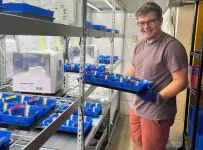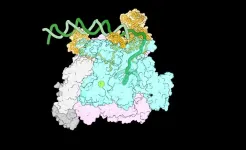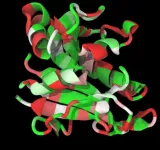(Press-News.org) Researchers from the Butantan Institute and collaborators are developing a more potent version of the BCG vaccine that protects against tuberculosis. While the conventional immunizer reduced infection by 90% in experiments with mice, the so-called recombinant BCG increased the protection rate to 99%. In addition, the new formulation protected the animals for a significantly longer period of time.
“BCG is the first vaccine we receive at birth, and it’s indeed effective in protecting children. But immunity against the disease tends to wane in adulthood, and as bacteria are becoming resistant to antibiotics, no one is safe. There’s been a global effort to try to improve the prevention of pulmonary tuberculosis in adults. Today, there are about 10 million new cases and 1.5 million deaths per year in the world,” told Agência FAPESP Luciana Cezar de Cerqueira Leite, a researcher at Butantan Institute’s Vaccine Development Laboratory, which is supported by FAPESP.
To understand why recombinant BCG leads to a stronger and longer-lasting immune response, the Butantan group and collaborators from several countries have adopted an approach known as systems biology – in short, observing in an animal model the behavior of thousands of genes in different tissues (mainly the lungs and lymph nodes) throughout the assembly of the immune response. This involves sequencing hundreds of samples, followed by intensive bioinformatics and data mining.
Cerqueira Leite addressed this topic on June 29 during a presentation at FAPESP Week China. The panel, dedicated to health and biomedicine issues, also included Zhang Zhiyong of Guangzhou Medical University, Pedro Moraes-Vieira of the State University of Campinas (UNICAMP), Xin Jin, chief research scientist at the Chinese company BGI, and Dan Zhang, co-founder of the company Hillgene BioPharma, also from China. The mediators were Xin Jin (BGI) and Simone Appenzeller, a professor at UNICAMP.
“We sequenced all the RNA that was expressed and present in samples taken at different times: before the animal was immunized, seven and 90 days after immunization – when the challenge is performed [the bacteria are inoculated into the rodents’ noses] – and seven and 90 days after the challenge,” explains Cerqueira Leite.
Samples from three groups of mice were compared: one was not immunized, another received the conventional BCG, and a third was vaccinated with recombinant BCG. At each moment of analysis, the genes with increased or decreased expression in the different groups were compared.
“As early as seven days after immunization, a very big change could be seen in the group that received the recombinant version: about 200 genes were already being activated, while almost nothing happened in the conventional BCG group. After 90 days, the response to the conventional BCG began to decline, while it remained the same in the recombinant group. But the big news is that the two vaccines work through very different metabolic pathways and we’ve been able to map them. The data will be published soon,” reveals the researcher.
Turbocharged bacteria
The BCG vaccine, ubiquitous in Brazilian maternity wards, was developed over a hundred years ago by attenuating the bacterium that causes bovine tuberculosis (Mycobacterium bovis), which is very similar to that of human tuberculosis (M. tuberculosis).
Through genetic engineering, the recombinant version gained the ability to produce a fragment of a toxin originally secreted by Escherichia coli, a species commonly found in the human gut.
“Some E. coli bacteria produce heat-labile toxins, known by the acronym LT, which are highly immunogenic, i.e. they induce a strong response from the immune system. In the recombinant vaccine, we use a detoxified fragment of the LT toxin [called LTAK63]. It isn’t capable of causing disease, but it maintains immunogenicity, so it acts as an adjuvant to the BCG vaccine,” Leite explains.
The first studies using the recombinant BCG strategy were aimed at developing a neonatal pertussis vaccine, the researcher explained. “This is because BCG can be given at birth, while the currently available pertussis immunizer [the triple bacterial vaccine, or DTP] provides protection only from the age of six months. In this case, we use a fragment of the toxin produced by the pertussis bacterium [Bordetella pertussis],” she explains.
Given the promising results, the same platform has been used in the search for new and better vaccines against whooping cough, tuberculosis, pneumonia (caused by Streptococcus pneumoniae or pneumococcus) and schistosomiasis, as well as in the treatment of bladder cancer (in which case the vaccine is used to “wake up” the immune system and stimulate it to attack the tumor).
In experiments with an animal model of tuberculosis, recombinant BCG was found to reduce the amount of bacteria in the lungs a hundredfold and also to reduce inflammation in the organ. “In trying to kill the bacteria, the defense cells end up attacking everything nearby and causing tissue damage. But the lungs of the animals immunized with recombinant BCG are white and less inflamed. By detailing the mechanism of action of the two vaccines, we now understand why this happens,” says Leite.
All RNA sequencing was performed in Shenzhen, China, by the company BGI, which provides genomics services to laboratories all over the world. Researchers from the Shenzhen Institute of Advanced Technology, the University of São Paulo (USP), the Albert Einstein Israelite College of Health Sciences, Fiocruz Bahia, Novartis/GSK, the Institut Pasteur and the Federal University of Goiânia (UFG), among others, collaborated in the studies.
To find out more about FAPESP Week China, visit: fapesp.br/week/2024/china.
END
New tuberculosis vaccine results presented at FAPESP Week China
Researchers from the Butantan Institute and collaborators reveal why recombinant BCG induces a stronger and longer-lasting response than the conventional vaccine.
2024-07-03
ELSE PRESS RELEASES FROM THIS DATE:
Wastewater is a viable medium for growing lettuce in hydroponic systems, study shows
2024-07-03
URBANA, Ill. – Urban agriculture has the potential to improve food security through local, efficient, and sustainable food production. Examples of urban food systems include hydroponics, where plants grow in a nutrient solution without soil, and aquaponics, which combines hydroponics with raising fish in tanks.
A new study from the University of Illinois Urbana-Champaign examines the use of aquaponics wastewater as a growth medium for lettuce in a hydroponic system. This practice can potentially ...
Researchers capture never-before-seen view of gene transcription
2024-07-03
Every living cell transcribes DNA into RNA. This process begins when an enzyme called RNA polymerase (RNAP) clamps onto DNA. Within a few hundred milliseconds, the DNA double helix unwinds to form a node known as the transcription bubble, so that one exposed DNA strand can be copied into a complementary RNA strand.
How RNAP accomplishes this feat is largely unknown. A snapshot of RNAP in the act of opening that bubble would provide a wealth of information, but the process happens too quickly for current technology to easily capture visualizations ...
Do genes-in-pieces code for proteins that fold in pieces?
2024-07-03
A new study led by Rice University’s Peter Wolynes offers new insights into the evolution of foldable proteins. The research was published in the Proceedings of the National Academy of Sciences.
Researchers at Rice and the University of Buenos Aires used energy landscape theory to distinguish between foldable and nonfoldable parts of protein sequences. Their study illuminates the ongoing debate about whether the pieces of DNA that code for only part of a protein during their origins can fold on their own.
The researchers focused on the extensive relationship between exons in protein structures and the evolution of protein foldability. They highlighted ...
Can inflammation in early adulthood affect memory, thinking in middle age?
2024-07-03
MINNEAPOLIS – Having higher levels of inflammation in your 20s and 30s may be linked to having memory and thinking problems at middle age, according to a study published in the July 3, 2024, online issue of Neurology®, the medical journal of the American Academy of Neurology. The study looked at levels of C-reactive protein (CRP) in the blood. CRP is produced by the liver and increases when there is inflammation in the body. The study does not prove that having higher levels of this protein causes dementia. It only shows an association.
There are two kinds of inflammation. Acute inflammation happens when the body’s immune response jumps into action to fight off infection or ...
Poor health, stress in 20s takes toll in 40s with lower cognition
2024-07-03
Higher inflammation in young adulthood linked to lower performance in skills testing in midlife.
Young adults who have higher levels of inflammation, which is associated with obesity, physical inactivity, chronic illness, stress and smoking, may experience reduced cognitive function in midlife, a new study out of UC San Francisco has found.
Researchers previously linked higher inflammation in older adults to dementia, but this is one of the first studies to connect inflammation in early adulthood with lower cognitive abilities in midlife.
“We know from long-term studies that brain changes leading to Alzheimer’s ...
Scientists may have found how to diagnose elusive neuro disorder
2024-07-03
Progressive supranuclear palsy (PSP), a mysterious and deadly neurological disorder, usually goes undiagnosed until after a patient dies and an autopsy is performed. But now, UC San Francisco researchers have found a way to identify the condition while patients are still alive.
A study appearing in Neurology on July 3 has found a pattern in the spinal fluid of PSP patients, using a new high-throughput technology that can measure thousands of proteins in a tiny drop of fluid.
Researchers ...
Cracking the code for cerebellar movement disorders
2024-07-03
The cerebellum is a region of the brain that helps us refine our movements and learn new motor skills. Patients and mouse models experience many kinds of abnormal movements when their cerebellum is damaged. They can have uncoordinated and unbalanced movements, called ataxia. They can have atypical positioning of body parts or uncontrolled movements because their muscles are working against each other, called dystonia. Or they can have disruptive shaky movements, called tremors. Understanding how changes in a single brain region ...
Stability indicating RP-HPLC method for the estimation of impurities in esomeprazole gastro-resistant tablets by AQbD approach
2024-07-03
https://www.scienceopen.com/hosted-document?doi=10.15212/bioi-2024-0018
Announcing a new article publication for BIO Integration journal. Esomeprazole (ESO) gastro-resistant tablets (40 mg) are sold under the brand name, Zosa, which effectively manages conditions associated with the overproduction of gastric acid, including peptic ulcer disease and Zollinger-Ellison syndrome. This article quantifies impurities in esomeprazole using advanced analytical techniques known as analytical quality by design with high-performance liquid chromatography.
Buffer selection ...
Clinical implications and procedural complications in patients with patent foramen ovale concomitant with atrial septal aneurysm
2024-07-03
https://www.scienceopen.com/hosted-document?doi=10.15212/CVIA.2024.0038
Announcing a new article publication for Cardiovascular Innovations and Applications journal. Atrial septal aneurysm (ASA) is defined as excursion of the atrial septum exceeding 10 mm beyond the atrial septum into the right or left atrium, or a combined total excursion of 15 mm on the right and left sides during the cardiac cycle. According to previous studies, 20–40% of patent foramen ovale (PFO) cases are accompanied by ASAs. ASA is associated with the presence of PFO, left atrial dysfunction, cryptogenic stroke, migraine, and arterial embolism, thus making ...
Cryptocurrency investors are more likely to self-report “Dark Tetrad” personality traits alongside other characteristics
2024-07-03
Owning cryptocurrency may be associated with certain personality and demographic characteristics as well as a reliance on alternative or fringe social media sources, according to a study published July 3, 2024 in the open-access journal PLOS ONE by Shane Littrell from the University of Toronto, Canada, along with colleagues from the University of Miami, USA.
Anonymous trading and unregulated markets hallmark cryptocurrency’s unique subculture. While some consider the digital currency to be financially unreliable, hundreds of millions of global investors think otherwise.
This study identified various political, psychological, and social characteristics ...
LAST 30 PRESS RELEASES:
New expert guidance urges caution before surgery for patients with treatment-resistant constipation
Solar hydrogen can now be produced efficiently without the scarce metal platinum
Sleeping in on weekends may help boost teens’ mental health
Study: Teens use cellphones for an hour a day at school
After more than two years of war, Palestinian children are hungry, denied education and “like the living dead”
The untold story of life with Prader-Willi syndrome - according to the siblings who live it
How the parasite that ‘gave up sex’ found more hosts – and why its victory won’t last
When is it time to jump? The boiling frog problem of AI use in physics education
Twitter data reveals partisan divide in understanding why pollen season's getting worse
AI is quick but risky for updating old software
Revolutionizing biosecurity: new multi-omics framework to transform invasive species management
From ancient herb to modern medicine: new review unveils the multi-targeted healing potential of Borago officinalis
Building a global scientific community: Biological Diversity Journal announces dual recruitment of Editorial Board and Youth Editorial Board members
Microbes that break down antibiotics help protect ecosystems under drug pollution
Smart biochar that remembers pollutants offers a new way to clean water and recycle biomass
Rice genes matter more than domestication in shaping plant microbiomes
Ticking time bomb: Some farmers report as many as 70 tick encounters over a 6-month period
Turning garden and crop waste into plastics
Scientists discover ‘platypus galaxies’ in the early universe
Seeing thyroid cancer in a new light: when AI meets label-free imaging in the operating room
Neutrophil-to-lymphocyte ratio may aid risk stratification in depressive disorder
2026 Seismological Society of America Annual Meeting
AI-powered ECG analysis offers promising path for early detection of chronic obstructive pulmonary disease, says Mount Sinai researchers
GIMM uncovers flaws in lab-grown heart cells and paves the way for improved treatments
Cracking the evolutionary code of sleep
Medications could help the aging brain cope with surgery, memory impairment
Back pain linked to worse sleep years later in men over 65, according to study
CDC urges ‘shared decision-making’ on some childhood vaccines; many unclear about what that means
New research finds that an ‘equal treatment’ approach to economic opportunity advertising can backfire
Researchers create shape-shifting, self-navigating microparticles
[Press-News.org] New tuberculosis vaccine results presented at FAPESP Week ChinaResearchers from the Butantan Institute and collaborators reveal why recombinant BCG induces a stronger and longer-lasting response than the conventional vaccine.




